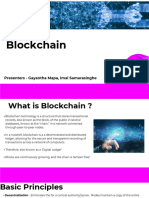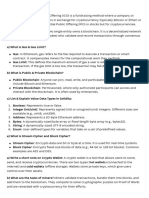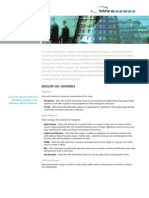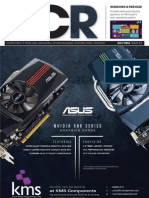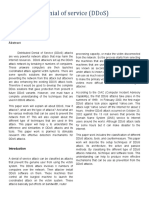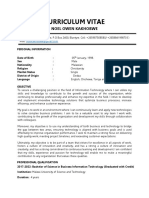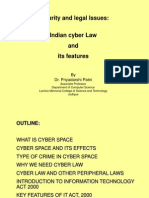BT Viva Questions
BT Viva Questions
Uploaded by
myemail.07012003Copyright:
Available Formats
BT Viva Questions
BT Viva Questions
Uploaded by
myemail.07012003Copyright
Available Formats
Share this document
Did you find this document useful?
Is this content inappropriate?
Copyright:
Available Formats
BT Viva Questions
BT Viva Questions
Uploaded by
myemail.07012003Copyright:
Available Formats
Questions Based on Assignments :
Assignment C-1 : Installation of MetaMask and study spending Ether per
transaction
1. What is Blockchain
Blockchain is a decentralized, digital ledger technology that records
transactions across multiple computers, ensuring transparency and security
without a central authority.
2. What is Cryptocurrency?
Cryptocurrency is a digital or virtual currency that uses cryptography for
security, operates on blockchain technology, and enables peer-to-peer
transactions without intermediaries, such as Bitcoin or Ethereum.
3. What are Transaction Wallets?
Transaction wallets are digital wallets that store cryptocurrencies and allow
users to send, receive, and manage their digital assets securely. Examples
include MetaMask and Trust Wallet.
4. What is an Ether Transaction?
An Ether transaction involves transferring Ether (ETH), the native currency of
the Ethereum blockchain, between wallets. Transactions are recorded on the
blockchain and require a small transaction fee.
5. Installation Process of MetaMask
• Step 1: Go to the MetaMask website or browser extension store.
• Step 2: Download and install MetaMask for your browser or mobile device.
• Step 3: Create a new wallet, set up a strong password, and securely store your
backup phrase.
• Step 4: Once set up, MetaMask is ready to manage Ether and other Ethereum-
based assets.
6. What Are the Different Types of Blockchain Technology?
• Public Blockchain: Open to everyone (e.g., Bitcoin, Ethereum).
• Private Blockchain: Restricted access for specific users.
• Consortium Blockchain: Controlled by a group of organizations.
• Hybrid Blockchain: Combines public and private features for flexibility.
7. What Are the Key Features/Properties of Blockchain?
• Decentralization: No central authority; data is spread across nodes.
• Transparency: Transactions are visible to all participants.
• Immutability: Data cannot be altered once added to the blockchain.
• Security: Cryptographic techniques secure data and transactions.
8. What is the Difference Between Ethereum and Bitcoin?
• Bitcoin: Primarily a digital currency for secure payments.
• Ethereum: A platform for creating decentralized applications (dApps) with
smart contract functionality, in addition to its currency, Ether.
9. What are Merkle Trees? Explain Their Concept.
Merkle Trees are a data structure used in blockchain to efficiently and securely
verify transactions. They organize transaction data into a tree structure, where
each leaf node is hashed, and hashes are combined up to form a single root
hash, providing an easy way to verify data integrity.
10. Give Real-Life Use Cases of Blockchain.
• Finance: Cross-border payments and decentralized finance (DeFi).
• Supply Chain: Tracking goods from production to delivery.
• Healthcare: Secure storage and sharing of patient records.
• Voting Systems: Transparent and tamper-proof voting records.
• Digital Identity: Managing digital identities and preventing fraud.
Assignment C-2 : Create your own wallet using Metamask.
1. What is Bitcoin?
Bitcoin is a decentralized digital currency created in 2009 by an anonymous
person or group known as Satoshi Nakamoto. It operates on blockchain
technology, allowing peer-to-peer transactions without the need for
intermediaries like banks.
2. What Are the Biggest Four Common Cryptocurrency Scams?
Phishing Scams: Fake websites or emails trick users into revealing private
keys.
Ponzi Schemes: Fraudulent investment schemes promising high returns.
Fake ICOs (Initial Coin Offerings): Scammers create fake tokens or projects to
get investors’ funds.
Rug Pulls: Developers abandon a project suddenly, taking investors' money.
3. Explain How Safe Are Money E-Transfers?
Money e-transfers can be safe when using secure networks and reputable
services. Encryption and authentication protocols make them secure, but users
should be cautious of phishing, hacking, or unauthorized access.
4. What is Cryptojacking and How Does It Work?
Cryptojacking is unauthorized use of someone’s computer or device to mine
cryptocurrency. Attackers install malware or use malicious scripts on websites
to hijack device resources, slowing down systems and potentially causing
damage.
Assignment C-3 : : Write a smart contract on a test network, for Bank account
1. What is a Smart Contract?
A smart contract is a self-executing contract with code that runs on a
blockchain. It automatically enforces terms and conditions agreed upon
by all parties.
2. What is a Test Network?
A test network (testnet) is a blockchain network used for testing smart
contracts and applications without real currency. Examples include
Ropsten and Goerli for Ethereum.
3. What is MetaMask, and why is it used?
MetaMask is a browser extension and wallet that allows users to manage
and interact with Ethereum-based assets and decentralized applications
(dApps). It’s used to deploy and test smart contracts on test networks.
4. Explain the Role of MetaMask in Smart Contract Deployment.
MetaMask connects to Ethereum networks and provides an account to
sign and send transactions, allowing users to deploy and test smart
contracts.
5. How Do You Deploy a Smart Contract on a Test Network?
• Write the smart contract code.
• Use Remix (online IDE) to compile the code.
• Connect MetaMask to Remix and choose a test network.
• Deploy the contract using MetaMask to sign and send the
transaction.
6. Explain the Deposit Operation in the Bank Account Smart
Contract.
The deposit function allows a user to send a specific amount of
cryptocurrency to their account balance within the smart contract.
7. Explain the Withdraw Operation in the Bank Account Smart
Contract.
The withdraw function enables a user to take money out of their account
balance, provided they have sufficient funds available.
8. How Does the Show Balance Operation Work in the Smart
Contract?
The show balance function returns the current balance of a user’s
account, showing how much cryptocurrency they have deposited in the
contract.
9. What Is the Objective of Using MetaMask and Test Network in
This Assignment?
The objective is to teach students how to interact with Ethereum
networks and deploy smart contracts, gaining practical experience in
blockchain technology and its applications.
10. What Are the Key Advantages of Using Smart Contracts for
Banking Operations?
• Transparency: All operations are recorded on the blockchain.
• Security: Transactions are encrypted and tamper-proof
• Automation: Smart contracts self-execute based on coded conditions.
11. How Do You Test and Verify the Smart Contract?
Use a test network to run transactions (deposit, withdraw, balance
check) and confirm they work as expected. Errors or bugs can be fixed
and retested
12. What Are Gas Fees, and Why Are They Relevant in Smart
Contracts?
Gas fees are the transaction costs required to run a smart contract on the
blockchain. They’re necessary for processing and securing transactions
but are lower on test networks.
Assignment C-4 : Solidity
1. What is Solidity?
Solidity is a high-level programming language designed for writing smart
contracts on the Ethereum blockchain, enabling developers to create
decentralized applications.
2. What is a Smart Contract?
A smart contract is a self-executing contract with terms directly written into
code, running on a blockchain, which automatically enforces the agreed-upon
conditions
3. What is the Purpose of Creating Student Data in a Smart Contract?
The purpose is to store and manage student information securely on the
blockchain, allowing for transparent and tamper-proof records.
4. What are Structures in Solidity?
Structures (structs) are user-defined data types that allow developers to group
related variables together, such as a student's name, age, and grade.
5. What are Arrays in Solidity?
Arrays are data structures that can store multiple values of the same type,
allowing for easy access and manipulation of collections of data, like a list of
students.
6. What is the Fallback Function in Solidity?
The fallback function is a default function that is called when a smart contract is
sent Ether without data or when no other function matches the call, allowing the
contract to handle unexpected transactions
You might also like
- Hotel Pre Opening ChecklistDocument28 pagesHotel Pre Opening Checklistkhairaniharun100% (3)
- 2024 Planned Technology Spend For CIOs in Canadian GovernmentDocument1 page2024 Planned Technology Spend For CIOs in Canadian GovernmentGautam Sehgal100% (1)
- Block Chain Unit-1Document17 pagesBlock Chain Unit-1paramata priya madhuriNo ratings yet
- Blockchain Unit-3Document33 pagesBlockchain Unit-3Anmol SinghNo ratings yet
- Blockchain Notes With QuestionsDocument9 pagesBlockchain Notes With QuestionsAniket SalunkheNo ratings yet
- Blockchain AnswersDocument11 pagesBlockchain Answersmrxmax12309No ratings yet
- Block ChainDocument35 pagesBlock ChainSai VamshiNo ratings yet
- Blockchain and Cryptocurrencies QADocument3 pagesBlockchain and Cryptocurrencies QAuncle.sharks.shopNo ratings yet
- Introduction To Cryptocurrency FinalDocument42 pagesIntroduction To Cryptocurrency FinalcryptoNo ratings yet
- w-23Document19 pagesw-23het102380No ratings yet
- DTUnit 3 & 4Document21 pagesDTUnit 3 & 423mdts59No ratings yet
- S-24Document15 pagesS-24het102380No ratings yet
- Imp QDocument13 pagesImp Qdivye.jainNo ratings yet
- Basics of CryptocurrenciesDocument12 pagesBasics of CryptocurrenciesAmulya SNo ratings yet
- Introduction To Cryptocurrency MasterDocument36 pagesIntroduction To Cryptocurrency MastercryptoNo ratings yet
- BCT Unit 1 ND 2 Notes byDocument69 pagesBCT Unit 1 ND 2 Notes byclashwizard41No ratings yet
- Programmable Money For The API EconomyDocument42 pagesProgrammable Money For The API Economysadiq106No ratings yet
- TRAINING Client Support CoinMetro - PART 1,2,3,4Document53 pagesTRAINING Client Support CoinMetro - PART 1,2,3,4Armando Gabriel CMNo ratings yet
- Introduction-to-Cryptocurrency FinalDocument42 pagesIntroduction-to-Cryptocurrency FinalcryptoNo ratings yet
- Understanding CryptocurrenciesDocument5 pagesUnderstanding Cryptocurrenciesberkoff111No ratings yet
- Untitled Document-1 PDFDocument9 pagesUntitled Document-1 PDFRitesh YadavNo ratings yet
- Block ChainDocument60 pagesBlock Chainromeesh jainNo ratings yet
- Smart Contracts With EthereumDocument20 pagesSmart Contracts With EthereumJP PrasadNo ratings yet
- Unit 12 - Reading NotesDocument5 pagesUnit 12 - Reading Notesshruti dambhareNo ratings yet
- DocumentDocument2 pagesDocumentJanseen mole AnastacioNo ratings yet
- Step by Step Towards Creating A Safe Smart Contract: Lessons and Insights From A Cryptocurrency LabDocument15 pagesStep by Step Towards Creating A Safe Smart Contract: Lessons and Insights From A Cryptocurrency Labattribute6428No ratings yet
- Experiment 8 (1Document6 pagesExperiment 8 (1pranayaws15No ratings yet
- Block ChainDocument6 pagesBlock Chainnecafo6170No ratings yet
- Ethereum The Basics US FINAL 1Document16 pagesEthereum The Basics US FINAL 1captain.amli.blocktechNo ratings yet
- Blockchain Course Outline Summary: 1. Mathematical Foundation For Blockchain (6 Hours)Document13 pagesBlockchain Course Outline Summary: 1. Mathematical Foundation For Blockchain (6 Hours)manasishivarkarNo ratings yet
- RGPV Is501 Unit 4Document13 pagesRGPV Is501 Unit 4Aayush SinhaNo ratings yet
- Blockchain - Mapa and ImalDocument21 pagesBlockchain - Mapa and Imalsapni udaraNo ratings yet
- Web 3Document5 pagesWeb 3Akhilesh RamNo ratings yet
- Cryptography and Network Security - Report 2Document19 pagesCryptography and Network Security - Report 2Syed HameedNo ratings yet
- Blockchain and Its Main ApplicabilityDocument17 pagesBlockchain and Its Main ApplicabilityBrigs MastermindNo ratings yet
- Block Chain Unit-4Document37 pagesBlock Chain Unit-4paramata priya madhuriNo ratings yet
- Block ChainDocument14 pagesBlock Chainiqbal ishak100% (1)
- Cryptocurrency and Its FormsDocument37 pagesCryptocurrency and Its FormsbajpaivinnieNo ratings yet
- research_paper_(crowdfunding) 7th semDocument5 pagesresearch_paper_(crowdfunding) 7th semAdarsh DevashishNo ratings yet
- PBT Assignment 2 AnswersDocument10 pagesPBT Assignment 2 AnswerssaniyainayathNo ratings yet
- BCT - Unit5Document29 pagesBCT - Unit5syednashita786No ratings yet
- w-22Document9 pagesw-22het102380No ratings yet
- ChatGPTDocument153 pagesChatGPTdikshaahire256No ratings yet
- Digital Assets EraDocument4 pagesDigital Assets Erachauhanaakash2831No ratings yet
- LESSON 5 Alternative Coins Ethereum and Smart ContractsDocument22 pagesLESSON 5 Alternative Coins Ethereum and Smart ContractsVictor AjraebrillNo ratings yet
- Transaction Tracking SystemDocument20 pagesTransaction Tracking SystemShubham KumarNo ratings yet
- 5 Basic Components of A Blockchain NetworkDocument5 pages5 Basic Components of A Blockchain NetworkAkshay HariNo ratings yet
- Unit 3 - Part 1Document12 pagesUnit 3 - Part 1shaikharmanazmi30No ratings yet
- BCT Unit - 4Document11 pagesBCT Unit - 4adityasatyaprakash9No ratings yet
- BCT Unit 3Document7 pagesBCT Unit 3g2368432No ratings yet
- BLOCHAINDocument6 pagesBLOCHAINPrajakta MhaskeNo ratings yet
- Unit I BCTDocument69 pagesUnit I BCTAkshay HariNo ratings yet
- b1d39728ce0e48c9b0bfa87a334c4891Document17 pagesb1d39728ce0e48c9b0bfa87a334c4891Swapnil SawaiNo ratings yet
- Report - Educational Certificate Verification System UsingDocument19 pagesReport - Educational Certificate Verification System UsingdevkiNo ratings yet
- IAT2 QB SolDocument77 pagesIAT2 QB SolmervismascarenhasNo ratings yet
- BCT_U4Document19 pagesBCT_U4Manoj kumarNo ratings yet
- Unit 3 - Blockchain TechnologyDocument7 pagesUnit 3 - Blockchain Technologywww.anonymous24No ratings yet
- BBPISSDocument9 pagesBBPISSmdprince1262No ratings yet
- KamyaVermaXI BDocument13 pagesKamyaVermaXI Bvermakamya238No ratings yet
- BCT Unit - 1Document10 pagesBCT Unit - 1adityasatyaprakash9No ratings yet
- Unit-5 SSL & TLS CSMDocument38 pagesUnit-5 SSL & TLS CSMposhitha.inaganti246No ratings yet
- ISS Type of AttacksDocument8 pagesISS Type of Attacksnaveendangi2094No ratings yet
- Malicious Uses and Abuses of Artificial IntelligenceDocument80 pagesMalicious Uses and Abuses of Artificial IntelligenceMr. XNo ratings yet
- SICAM A8000 Series-RTUs ApplicationNote For TLS ENGDocument20 pagesSICAM A8000 Series-RTUs ApplicationNote For TLS ENGAlan Rodriguez BarrosNo ratings yet
- Electronic Record and Signature DisclosureDocument4 pagesElectronic Record and Signature DisclosureAnuradha AmjuriNo ratings yet
- Lecture : BiometricsDocument15 pagesLecture : BiometricsBasantNo ratings yet
- B.Sc. (Hons) Cyber SecurityDocument3 pagesB.Sc. (Hons) Cyber SecuritywirdinaNo ratings yet
- Websense Master Database Url CategoriesDocument4 pagesWebsense Master Database Url Categorieshokum_bmNo ratings yet
- Database Security Using EncryptionDocument6 pagesDatabase Security Using EncryptionKRediNo ratings yet
- Eti MCQDocument21 pagesEti MCQjaibvp123No ratings yet
- HD SGHTH 9Document2 pagesHD SGHTH 9solicitadasenhaNo ratings yet
- (MegaBlaze Com) PCR JulyDocument116 pages(MegaBlaze Com) PCR JulyWan Mohd FirdausNo ratings yet
- Security + Study GuideDocument59 pagesSecurity + Study GuideDavid EdwardNo ratings yet
- AUSTRALIAN DEFENCE FORCE PUBLICATION INFORMATION OPERATIONS PLANNING MANNUAL - DraftDocument86 pagesAUSTRALIAN DEFENCE FORCE PUBLICATION INFORMATION OPERATIONS PLANNING MANNUAL - DraftMatt100% (2)
- Resume Network and SecurityDocument3 pagesResume Network and Securitycisco012No ratings yet
- Security Assessment and TestingDocument43 pagesSecurity Assessment and TestingZulfikar100% (1)
- Lab - Detecting Threats and Vulnerabilities: ObjectivesDocument3 pagesLab - Detecting Threats and Vulnerabilities: ObjectivesObaid AnwerNo ratings yet
- BrazilDocument9 pagesBrazilNur Khairun Hanis Abu BakarNo ratings yet
- Lab9 Using Mine Meld For IoC Feed AggregationDocument18 pagesLab9 Using Mine Meld For IoC Feed Aggregationsaravanasanthosh_uNo ratings yet
- Ilovepdf MergedDocument11 pagesIlovepdf MergedManav PARMARNo ratings yet
- CH 13 - InfoSys SecurityDocument30 pagesCH 13 - InfoSys SecurityonemoreoutthedoorNo ratings yet
- Examination 1Document4 pagesExamination 1Dolores Mayuga PanchoNo ratings yet
- Class 12 CS Project SampleDocument21 pagesClass 12 CS Project Samplevickyprasadmukandpur2482000No ratings yet
- Distributed Denial of ServiceDocument2 pagesDistributed Denial of ServiceneelakshijollyNo ratings yet
- CV - Noel Kakhobwe New April 2023 PDFDocument8 pagesCV - Noel Kakhobwe New April 2023 PDFNoel Owen KakhobweNo ratings yet
- Computer Security NoteDocument89 pagesComputer Security NoteMangala SemageNo ratings yet
- CONCEPT MAP - Operating SystemDocument1 pageCONCEPT MAP - Operating SystemJovanie CadungogNo ratings yet
- Security and Legal Issues:: by Dr. Priyadarshi PatniDocument30 pagesSecurity and Legal Issues:: by Dr. Priyadarshi Patnibest_16decNo ratings yet































